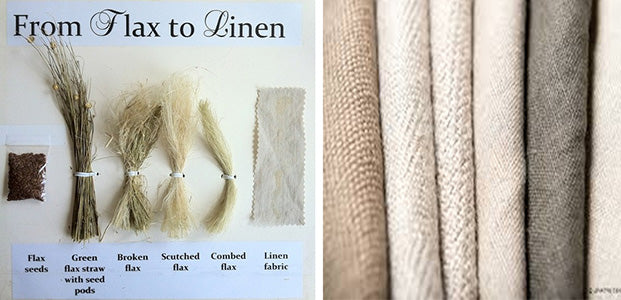I’ve talked a lot about dyeing protein fibers before at various platforms and even dabbled in some deeper tones for linen. Well, flax linen can be a bit of a rebel when it comes to taking up color, but I promise it’s worth the effort. If you are working with natural dyeing and plant-based fibers, you will love this experience, just like I did my first time. So, let’s see the whole process of how to dye Flax Linen Naturally to Oatmeal Color. Be ready; you will soon get some amazing facts and tricks.
What Is Flax Linen?
People who have experience working with linen before are already halfway there. But let’s just quickly recap. Flax linen comes from the fibers of the flax plant. It’s a breathable and lightweight material and is incredibly strong, among others.
When we compare it with animal fibers like wool or silk (aka protein fibers), flax is different in composition. It is cellulose-based fabric instead of protein, which is why it behaves a little differently in the dye pot.
And this is the real challenge. You have to deal with flax linen, which is a stubborn fabric. It doesn’t always grab color as easily as wool does. But not in my case, as I have some hidden secrets that make how to dye Flax Linen Naturally to Oatmeal Color the easiest thing. So, if you want to see how this stubborn fiber becomes the most satisfying one to dye, especially when you aim for subtle tones like oatmeal, keep reading.
Why Oatmeal?

Oatmeal is something incredibly timeless, as it’s not too warm or too cool. You can pair it with everything. People having sustainable, earthy wardrobes or home decor must find this shade great as it naturally fits into their settings. But getting this color naturally from plants or materials takes a bit of thought.
Oatmeal is a natural dye shade. It falls somewhere between soft beige and pale brown. That means we’re looking for dye sources that can give us mild tannin tones without going too dark or too yellow. More on that in a minute.
How to Dye Flax Linen Naturally to Oatmeal Color
Prepping Flax Linen for Dyeing
Before we talk about what plants or materials to use for getting oatmeal color, we need to prep our linen. Beginners might try to skip this step or rush through. Don’t do it! If your linen is not ready, how do you get the final color?
Step 1: Scour Your Linen
Linen fibers often come with waxy residues from processing. These can block the dye from bonding properly.
- Fill a large pot with water and add a mild pH-neutral soap, like Orvus Paste or eco-friendly dish soap.
- Gently simmer the linen for about an hour.
- Rinse the linen thoroughly and dry it completely.
- If you don’t want to rinse it, proceed directly to mordanting.
Step 2: Mordanting
Mordant is important while dealing with cellulose fibers. When I discuss how to dye flax linen naturally to oatmeal color, I use a mix of oak galls for tannin, followed by alum.
There is another famous soya milk method popularized by Rebecca Desnos. It’s good for food-safe and gentle dyeing of linen, but I personally find the oak gall + alum combo more effective for achieving consistent oatmeal tones on linen.
Let’s Achieve Oatmeal on Flax Linen With My Proven Method

Now, it’s time to fully focus on our main topic: how to dye flax linen naturally to oatmeal color.
Materials You’ll Need:
- Flax linen (pre-scoured, about 100g)
- Oak galls (25–50g, crushed)
- Alum (aluminium sulfate, 10–12% WOF)
- Dye source: used tea leaves, avocado skins, or pomegranate peels
- Large dye pot (used for dyeing only)
- Gloves and sieve
- Cheesecloth
- Most importantly, patience
My Dyeing Process of How to Dye Flax Linen Naturally to Oatmeal Color
Step 1: Tannin Bath with Oak Galls
- Crush oak galls into small pieces and wrap them in cheesecloth.
- Simmer in water for 1 hour to extract the tannin.
- Put your pre-wetted linen in the pot and simmer gently (not boil) for another hour.
- Give it time to cool down and sit overnight.
When you tannin the flax linen, it will destroy its stubbornness. It means it makes it better to grab the alum and dye more effectively. This whole process helps you get the creamy beige base, which works as a base foundation to build your oatmeal tone.
Step 2: Mordanting with Alum
- You know what the weight of your fiber is?
- After knowing the weight, prepare a mordant bath with 10–12% alum as per the fiber weight.
- Now, put your tannin-treated linen into this bath. Simmer it gently for about an hour.
- Take a rest, as it needs time to cool down, and sit overnight for deeper absorption.
- The next morning, rinse it gently. Now, guess what? Your flax linen is ready to dye oatmeal shade.
Step 3: Ready for Dye Bath, But First Choose Your Source
Oatmeal is a different color, and to achieve this, you need something with a mild beige or warm brown dye tone. I found some natural dye sources for oatmeal shades, like
- Used black tea leaves
- Avocado Skins
- Pomegranate Peels
- Acorns or Maple Bark Tea
I choose black tea leaves
- Take leaves equal to the linen weight
- Simmer for one hour and cool it
- Strain out all solids to avoid blotchy spots.
- Put mordanted linen and heat it for 1 hour
- Let it cool and soak overnight.
Final Rinsing
Cold rinse the next morning and dry it naturally in the shade. You get natural oatmeal.
Conclusion
How to dye flax linen naturally to oatmeal color is a simple process if you follow the right method. I have shared mine, which gives a perfect result; you can share yours, and we will appreciate each other.
